
Mario Kart 64 is a kart racing video game developed and published by Nintendo for the Nintendo 64. It is the second main entry in the Mario Kart series and is the successor to Super Mario Kart (1992) for the Super Nintendo Entertainment System. It was released in Japan on December 14, 1996; in North America on February 10, 1997; in the United Kingdom on June 13, 1997; and in Europe on June 24, 1997. It was released for the iQue Player in China on December 25, 2003. It was released on the Wii and Wii U Virtual Console in 2007 and 2016, and on the Nintendo Switch Online + Expansion Pack on October 25, 2021.

F-Zero X is a futuristic racing video game for the Nintendo 64 console. Developed by Nintendo's EAD division, it was released in Japan, North America, and Europe in 1998. In 2000, the Expansion Kit was released in Japan, including a track and vehicle editor. The original game was ported in 2004 to the iQue Player in China. It had Virtual Console re-releases on the Wii in 2007 and the Wii U around nine years later. On March 11, 2022, the game was re-released on Nintendo Switch Online + Expansion Pack, featuring online multiplayer.

Rock n' Roll Racing is a vehicular combat-based racing video game developed by Silicon & Synapse and published by Interplay Productions for the Super Nintendo Entertainment System in 1993 and the Mega Drive/Genesis in 1994. The game prominently features a number of popular heavy metal and rock songs in its soundtrack, hence the game's title. The game was ported to the Game Boy Advance in 2003. In celebration of the company's 30th anniversary, Rock n' Roll Racing was re-released for Microsoft Windows, Nintendo Switch, PlayStation 4 and Xbox One as part of the Blizzard Arcade Collection in February 2021.

Diddy Kong Racing is a 1997 racing video game developed and published by Rare for the Nintendo 64. The game is set on Timber's Island and revolves around Diddy Kong and his friends' attempt to defeat the intergalactic antagonist, a wizarding pig named Wizpig, through winning a series of races. The player can take control of any of the featured characters throughout the game. Diddy Kong Racing features five worlds with four racetracks each, and the ability to drive a car, hovercraft, or pilot an aeroplane.

Cruis'n USA is an arcade racing game originally released in 1994. It was developed by Eugene Jarvis' company TV Games Inc., and manufactured by Midway Games. It is the first game in the Cruis'n series and features races set in locations across the continental United States.

Cruis'n World is the 1996 sequel to the 1994 arcade racer Cruis'n USA. Cruis'n World allows players to race on various tracks around the world. The game also features more cars than Cruis'n USA. This game introduced stunts to the Cruis'n series. They served to dodge obstacles, take close curves and so. If the stunt makes the vehicle fly in the air, the game gives the player extra seconds of time. The game also uses small rocket boosts to speed up.
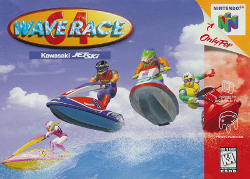
Wave Race 64 is a 1996 racing video game developed and published by Nintendo for the Nintendo 64. Gameplay involves the player racing on a personal watercraft on a variety of courses while successfully manoeuvring the vehicle around various buoys. A multiplayer mode where two players can compete against each other on a chosen course is also included. The game supports the Controller Pak, which allows players to transfer saved data from one game cartridge to another.

Street Racer is a racing video game published by Ubisoft for various systems. It was released for the Super Nintendo Entertainment System in 1994, Sega Mega Drive in 1995, PlayStation, Sega Saturn and Game Boy in 1996 and PC and Amiga in 1997. Marketed as a "cross between Mario Kart and Street Fighter", the go-kart themed game combined racing with comedy and beat 'em up influenced violence. The game was a success on the SNES and Mega Drive and received mixed reviews across platforms.

Top Gear Rally is a 1997 racing video game developed by Boss Game Studios and released for the Nintendo 64. A follow-up to Kemco's original Top Gear game, it features a championship mode where a single player must complete six seasons of two to four races, as well as a multiplayer mode where two players may compete against each other via a split-screen display. The game's tracks combine both road and off-road surfaces and can be played in different weather conditions, including night, fog, rain, and snow. Players may customize their car with different tire grips and adjust its suspension stiffness and steering sensitivity. An option that allows players to custom paint their cars is also included.

Need for Speed II is a racing video game released in 1997 for PlayStation and Microsoft Windows. It is a part of the Need for Speed series and is the second installment, following The Need for Speed.

V-Rally is a racing video game developed by Infogrames Multimedia and released for the PlayStation console in 1997. The first game in the V-Rally series, it is based on the 1997 and 1998 World Rally Championship seasons, and features officially licensed cars and tracks inspired by real locations of rally events. Players drive rally cars through a series of stages spread over eight different locations, ranging from European countries like England, Spain or Sweden, to island countries such as Indonesia and New Zealand. As a simulation game, V-Rally places a strong emphasis on replicating the behavior physics of real cars and generally requires more practice than arcade-style racers.

Beetle Adventure Racing! is a racing game released for the Nintendo 64 in 1999. It was developed by Paradigm Entertainment along with EA Canada and published by Electronic Arts. Each vehicle in the game is a Volkswagen New Beetle, which was released the previous year. The gameplay involves racing other players on unlocked tracks, finding and destroying crates, and collecting colored ladybugs while battling other players. The single-player championship offers three circuits and a secret bonus circuit with new vehicles and tracks available upon completion.

MRC: Multi-Racing Championship, also known as simply Multi Racing Championship, is a racing video game developed by Genki and released for the Nintendo 64 in 1997. It was published in North America and Europe by Ocean and in Japan by Imagineer. The game is compatible with the Controller Pak and the Rumble Pak.
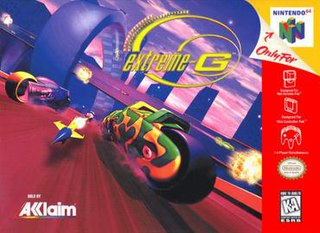
Extreme-G is a futuristic racing video game developed by Probe Entertainment and published by Acclaim Entertainment, featuring an original trance soundtrack. It was released for the Nintendo 64 in 1997, and was released in Japan on May 29, 1998. Despite the crowded field of Nintendo 64 racing games, Extreme-G was met with moderately positive reviews and was a commercial success. A sequel, Extreme-G 2, was released in 1998, followed by two additional games: Extreme-G 3 and XGRA: Extreme G Racing Association.
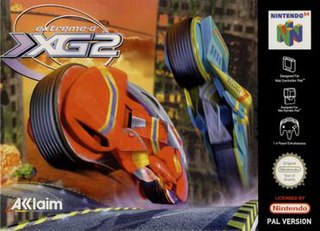
Extreme-G 2, also known as Extreme G: XG2, is a racing video game developed by Probe Entertainment and published by Acclaim Entertainment for Nintendo 64 and Microsoft Windows. It is the sequel to Extreme-G and is followed by Extreme-G 3.

AeroGauge is a futuristic, sci-fi hovercraft racing game designed for the Nintendo 64 game console and released in 1998. ASCII's AeroGauge is conceptually similar to Psygnosis' Wipeout or Acclaim's Extreme G. The main difference is that the vehicles in the game fly instead of hovering, so it's possible to maneuver them in the air. AeroGauge garnered mediocre reviews, with criticism directed at its routine concept, excessive pop up, lack of weapons and power-ups, and overly high difficulty.
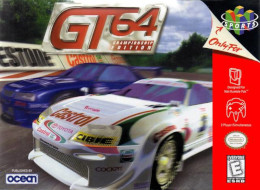
GT 64: Championship Edition, known as City Tour GrandPrix: Zen Nihon GT Senshuken in Japan, is a racing video game developed by Imagineer and released for the Nintendo 64 console in 1998. It is an official licensed game to All-Japan GT Championship, featuring cars and drivers of the 1997 All Japan Grand Touring Car Championship.

Hot Wheels Turbo Racing is a racing video game released for the Nintendo 64 and PlayStation in 1999. It features 40 cars based on the Hot Wheels series of toys. It also features Kyle Petty's 1999 NASCAR stock car, as it was sponsored by Hot Wheels. The game features music from artists like Primus, Metallica, The Reverend Horton Heat and Mix Master Mike.
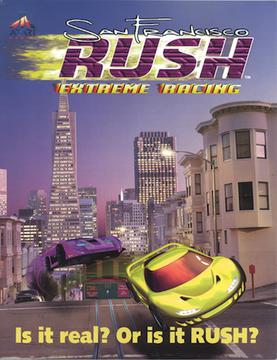
San Francisco Rush: Extreme Racing is a video game developed and published by Atari Games. This game was first released in arcades in 1996 and was ported to Nintendo 64 in 1997 and the PlayStation in 1998. San Francisco Rush: Extreme Racing is the first game in the Rush series.

Ridge Racer 3D is a racing video game for the Nintendo 3DS console published and developed by Namco Bandai Games. The game was released in Japan on 26 February 2011 and in North America on 22 March, five days prior to the launch of the Nintendo 3DS itself in that region. Ridge Racer 3D was also released in Europe on 25 March and in Australia on 31 March.




















